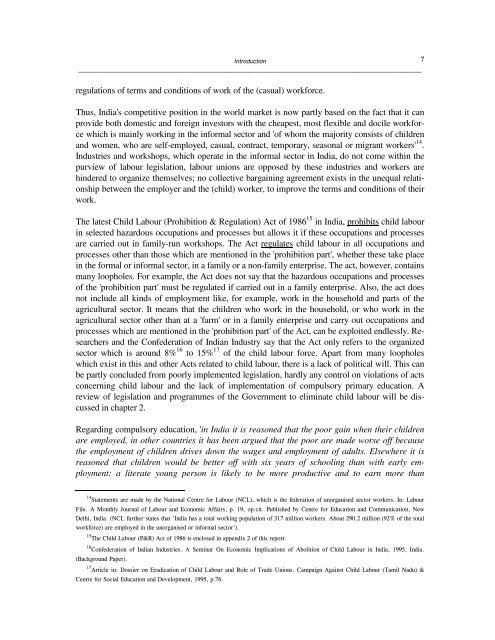Create successful ePaper yourself
Turn your PDF publications into a flip-book with our unique Google optimized e-Paper software.
Introduction<br />
──────────────────────────────────────────────────────────────────────────────────────────────<br />
regulations <strong>of</strong> terms <strong>and</strong> conditions <strong>of</strong> work <strong>of</strong> <strong>the</strong> (casual) workforce.<br />
Thus, <strong>India</strong>'s competitive position <strong>in</strong> <strong>the</strong> world market is now partly based on <strong>the</strong> fact that it can<br />
provide both domestic <strong>and</strong> foreign <strong>in</strong>vestors with <strong>the</strong> cheapest, most flexible <strong>and</strong> docile workforce<br />
which is ma<strong>in</strong>ly work<strong>in</strong>g <strong>in</strong> <strong>the</strong> <strong>in</strong>formal sector <strong>and</strong> '<strong>of</strong> whom <strong>the</strong> majority consists <strong>of</strong> children<br />
<strong>and</strong> women, who are self-employed, casual, contract, temporary, seasonal or migrant workers' 14 .<br />
Industries <strong>and</strong> workshops, which operate <strong>in</strong> <strong>the</strong> <strong>in</strong>formal sector <strong>in</strong> <strong>India</strong>, do not come with<strong>in</strong> <strong>the</strong><br />
purview <strong>of</strong> <strong>labour</strong> legislation, <strong>labour</strong> unions are opposed by <strong>the</strong>se <strong>in</strong>dustries <strong>and</strong> workers are<br />
h<strong>in</strong>dered to organize <strong>the</strong>mselves; no collective barga<strong>in</strong><strong>in</strong>g agreement exists <strong>in</strong> <strong>the</strong> unequal relationship<br />
between <strong>the</strong> employer <strong>and</strong> <strong>the</strong> (child) worker, to improve <strong>the</strong> terms <strong>and</strong> conditions <strong>of</strong> <strong>the</strong>ir<br />
work.<br />
The latest <strong>Child</strong> Labour (Prohibition & Regulation) Act <strong>of</strong> 1986 15 <strong>in</strong> <strong>India</strong>, prohibits child <strong>labour</strong><br />
<strong>in</strong> selected hazardous occupations <strong>and</strong> processes but allows it if <strong>the</strong>se occupations <strong>and</strong> processes<br />
are carried out <strong>in</strong> family-run workshops. The Act regulates child <strong>labour</strong> <strong>in</strong> all occupations <strong>and</strong><br />
processes o<strong>the</strong>r than those which are mentioned <strong>in</strong> <strong>the</strong> 'prohibition part', whe<strong>the</strong>r <strong>the</strong>se take place<br />
<strong>in</strong> <strong>the</strong> formal or <strong>in</strong>formal sector, <strong>in</strong> a family or a non-family enterprise. The act, however, conta<strong>in</strong>s<br />
many loopholes. For example, <strong>the</strong> Act does not say that <strong>the</strong> hazardous occupations <strong>and</strong> processes<br />
<strong>of</strong> <strong>the</strong> 'prohibition part' must be regulated if carried out <strong>in</strong> a family enterprise. Also, <strong>the</strong> act does<br />
not <strong>in</strong>clude all k<strong>in</strong>ds <strong>of</strong> employment like, for example, work <strong>in</strong> <strong>the</strong> household <strong>and</strong> parts <strong>of</strong> <strong>the</strong><br />
agricultural sector. It means that <strong>the</strong> children who work <strong>in</strong> <strong>the</strong> household, or who work <strong>in</strong> <strong>the</strong><br />
agricultural sector o<strong>the</strong>r than at a 'farm' or <strong>in</strong> a family enterprise <strong>and</strong> carry out occupations <strong>and</strong><br />
processes which are mentioned <strong>in</strong> <strong>the</strong> 'prohibition part' <strong>of</strong> <strong>the</strong> Act, can be exploited endlessly. Researchers<br />
<strong>and</strong> <strong>the</strong> Confederation <strong>of</strong> <strong>India</strong>n Industry say that <strong>the</strong> Act only refers to <strong>the</strong> organized<br />
sector which is around 8% 16 to 15% 17 <strong>of</strong> <strong>the</strong> child <strong>labour</strong> force. Apart from many loopholes<br />
which exist <strong>in</strong> this <strong>and</strong> o<strong>the</strong>r Acts related to child <strong>labour</strong>, <strong>the</strong>re is a lack <strong>of</strong> political will. This can<br />
be partly concluded from poorly implemented legislation, hardly any control on violations <strong>of</strong> acts<br />
concern<strong>in</strong>g child <strong>labour</strong> <strong>and</strong> <strong>the</strong> lack <strong>of</strong> implementation <strong>of</strong> compulsory primary education. A<br />
review <strong>of</strong> legislation <strong>and</strong> programmes <strong>of</strong> <strong>the</strong> Government to elim<strong>in</strong>ate child <strong>labour</strong> will be discussed<br />
<strong>in</strong> chapter 2.<br />
Regard<strong>in</strong>g compulsory education, '<strong>in</strong> <strong>India</strong> it is reasoned that <strong>the</strong> poor ga<strong>in</strong> when <strong>the</strong>ir children<br />
are employed, <strong>in</strong> o<strong>the</strong>r countries it has been argued that <strong>the</strong> poor are made worse <strong>of</strong>f because<br />
<strong>the</strong> employment <strong>of</strong> children drives down <strong>the</strong> wages <strong>and</strong> employment <strong>of</strong> <strong>adult</strong>s. Elsewhere it is<br />
reasoned that children would be better <strong>of</strong>f with six years <strong>of</strong> school<strong>in</strong>g than with early employment:<br />
a literate young person is likely to be more productive <strong>and</strong> to earn more than<br />
7<br />
14 Statements are made by <strong>the</strong> National Centre for Labour (NCL), which is <strong>the</strong> federation <strong>of</strong> unorganised sector workers. In: Labour<br />
File. A Monthly Journal <strong>of</strong> Labour <strong>and</strong> Economic Affairs, p. 19, op.cit. Published by Centre for Education <strong>and</strong> Communication, New<br />
Delhi, <strong>India</strong>. (NCL fur<strong>the</strong>r states that '<strong>India</strong> has a total work<strong>in</strong>g population <strong>of</strong> 317 million workers. About 290.2 million (92% <strong>of</strong> <strong>the</strong> total<br />
workforce) are employed <strong>in</strong> <strong>the</strong> unorganised or <strong>in</strong>formal sector').<br />
15 The <strong>Child</strong> Labour (P&R) Act <strong>of</strong> 1986 is enclosed <strong>in</strong> appendix 2 <strong>of</strong> this report.<br />
16 Confederation <strong>of</strong> <strong>India</strong>n Industries. A Sem<strong>in</strong>ar On Economic Implications <strong>of</strong> Abolition <strong>of</strong> <strong>Child</strong> Labour <strong>in</strong> <strong>India</strong>, 1995, <strong>India</strong>.<br />
(Background Paper).<br />
17 Article <strong>in</strong>: Dossier on Eradication <strong>of</strong> <strong>Child</strong> Labour <strong>and</strong> Role <strong>of</strong> Trade Unions. Campaign Aga<strong>in</strong>st <strong>Child</strong> Labour (Tamil Nadu) &<br />
Centre for Social Education <strong>and</strong> Development, 1995, p.76.


















